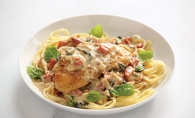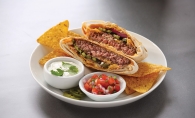To make the most of the citrus season, we turned to Rachael Perron, culinary director for Kowalski’s Companies, and Rick Frazer, executive chef at Cravings Wine Bar and Grille, for some suggestions and recipes. “It can be no coincidence that most citrus fruits resemble the sun,” Perron says. “These sunny beauties can provide a bright, happy note in wintry dishes including grains, fish, salads and baked goods; they’re also great as a snack or make a perfectly simple and satisfying dessert on their own.”
Frazer enjoys incorporating citrus to uplift and brighten dishes during the long cold winter. “Cooking in the winter can become pretty monotonous,” he says. “I have some favorite recipes I like to use frequently to break up the long winter and give me a shot of summer.”
Citrus 101
Oranges: Oranges may have seeds or be seedless; the most popular varieties are navel, Valencia and blood oranges. They are an excellent source of vitamin C and contain some vitamin A.
Tangerines and Clementines: Both are types of oranges also known as Mandarin oranges; their skin is loose and their segments divide with ease.
Grapefruits: Grapefruits from Florida and Texas usually arrive in October and last until June. They are sold as either white or pink and are called grapefruits because they grow in grape-like clusters. Grapefruits are a good source of vitamin C.
Kumquats: These grape-shaped citrus fruits contain good amounts of potassium and vitamins A and C. The flesh is edible. Eat them whole or slice them into salads.
Lemons: Good in sweet and savory dishes, the flesh is tart and slightly acidic. The grated zest is delicious in baked goods, salad dressings and grain dishes.
Limes: Persian limes are the most common variety. Key limes are smaller and more yellow. Very popular in mixed drinks and marinades.
Citrus Tips from Rachael Perron
• Cut orange segments for eating by slicing “between the poles,” not through them; then slice into easy-to-eat wedges.
• Add lemon and lime zest to rice and grain dishes, salad dressings and salads.
• To get the most juice from your citrus, squeeze them at room temperature or microwave them for up to 10 seconds first.
• Color isn’t a good indicator of ripeness for citrus fruit. To select the best fruit, pick pieces that are heavy for their size. To do this, pick similarly sized fruits and choose the heavier of those you test. Fragrant fruits are also generally good choices. Avoid fruits with blemishes or soft spots.
Tequila Lime Shrimp Tacos (Rick Frazer)
Marinade:
3 Tbsp. lime juice
3 Tbsp. tequila
1 tsp. chopped garlic
1 tsp. cumin
1 Tbsp. chopped cilantro
1 lb. shrimp
Place all ingredients in a ziplock bag, seal the bag and place in refrigerator for 1 hour.
Slaw:
3 cups shredded cabbage
2 Tbsp. rice wine vinegar
1 tsp. canola oil
2 Tbsp. honey
Mix vinegar, oil and honey; season with salt and pepper. Toss cabbage with dressing and set aside.
Other Ingredients:
8 corn tortillas
La Chona Mexican sour cream
Remove shrimp from marinade and saute until just cooked, about 2 minutes per side. Heat tortillas over high heat in a dry saute pan for 30 seconds per side. Place 1 tsp. teaspoon of sour cream in the center of the tortilla shells; top with shrimp and slaw. Optional garnishes: lime wedges, sliced avocado, chopped fresh cilantro. Serves 4.
Winter Citrus Salad (Rachael Perron)
2 heads Bibb lettuce
4 oz. jicama sticks
2 clementines, peeled, cut crosswise into ¼" slices, quartered
3 red onion slices, separated
⅓ cup pepitas, toasted
¼ cup chopped fresh cilantro
Shaved Parmesan cheese, to taste
Kowalski’s Citrus Vinaigrette, to taste
Rinse lettuce and spin thoroughly dry; tear into bite-sized pieces. In a large bowl, combine lettuce with remaining ingredients except dressing; toss with dressing. Serve immediately. Serves 8.
Citrus Tips from Rachael Perron
• When you want to use the juice and zest of a citrus fruit, zest first then squeeze the fruit to extract the juice.
• You can save a zested citrus fruit, but wrap it well in plastic and use as soon as possible. The juice in a zested lemon will oxidize and turn bitter quickly.
• For the most pronounced citrus flavor in baked goods, use zest in the batter (citrus juice becomes very muted in baked products). For even more fruity oomph, brush muffins, quick breads and cakes with a citrusy simple syrup (made from equal parts citrus juice and dissolved sugar) and/or make a simple citrus glaze with 1 cup powdered sugar and 3-4 teaspoons citrus juice.
• To supreme citrus fruit, slice off the ends down to the flesh and place one of these flat ends on a stable cutting board. Use a sharp knife to cut down toward the board (between the cut ends), moving the knife with the contour of the fruit to remove all of the peel and white pith, down to the brightly colored flesh. Hold the peeled fruit in one hand (membranes running across your open palm) over a large bowl; using a sharp knife in your other/cutting hand, carefully cut down into the fruit alongside the membranes to release the segments into the bowl below. Squeeze the remnants of the fruit (the membranes) over the bowl to extract every last drop of juice.
Lemon Basmati Rice with Pine Nuts (Rachel Perron)
1½ cups water
1 cup basmati rice
2 Tbsp. fresh-squeezed lemon juice
1 Tbsp. grated lemon zest
Extra virgin olive oil, for serving
½ cup pine nuts, toasted
Fresh Italian parsley, chopped, to taste
Freshly ground sea salt and black peppercorns, to taste
Add first three ingredients to a rice cooker; cook according to manufacturer’s instructions. When rice is done, let stand 5 minutes; add zest and fluff with a fork. Drizzle with oil to taste. Add pine nuts, parsley and seasonings to taste. Serves 4.
Lemon Bars (Rick Frazer)
Crust:
10 ½ Tbsp. unsalted butter (at room temperature)
¼ cup sugar
1 tsp. vanilla extract
1 ¾ cup flour
Combine sugar and butter in the bowl of a mixer fitted with paddle and mix for 3 minutes. Scrape down the sides of the bowl and add vanilla, then add flour ¼ cup at a time until dough forms. Turn out dough onto a 9x13 baking pan fitted with parchment paper long enough to hang over the sides of the pan by 2 inches ( it will help with removal of the bars) and press dough to fit the pan. Chill dough for ½ hour.
Preheat oven to 350 degrees. Remove dough from fridge after it's chilled and prick all over with fork to prevent it from rising while it cooks. Cook until golden brown about 20 minutes, remove from oven and let cool. Next step: make the curd.
Curd:
1 cup lemon juice
1 ¼ cup sugar
6 eggs
6 egg yolks
9 Tbsp. butter cut into small chunks
Mix lemon juice, sugar, eggs and yolks in a bowl over a double boiler. Whisk until mixture thickens and holds shape when whisk is removed, about 5 minutes or so. Remove from heat and whisk in butter a few chunks at a time. Pour through a fine strainer onto the crust wrap with plastic wrap and freeze until solid. Using the parchment, slowly pull the bars from the pan and let defrost at room temperature for 10 minutes. When thawed enough to get a knife through the bars, cut into equal squares. Top with whipped cream, powdered sugar or my favorite, meringue. NOTE: One thing I like about the curd recipe is you can use any citrus juice for this recipe. Sometimes I like to use orange juice and drizzle them with chocolate.









